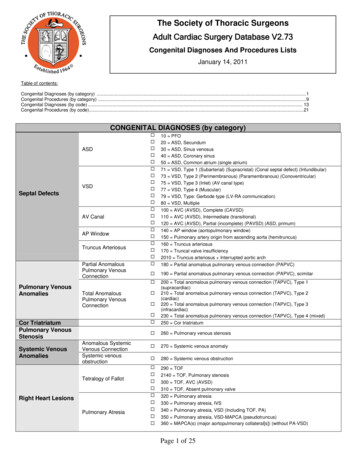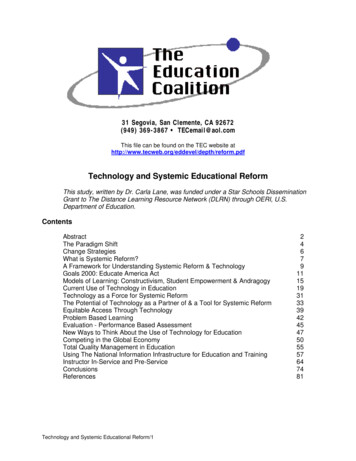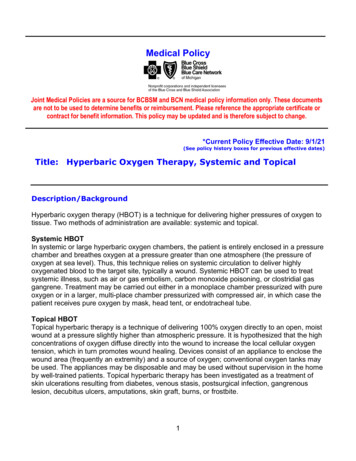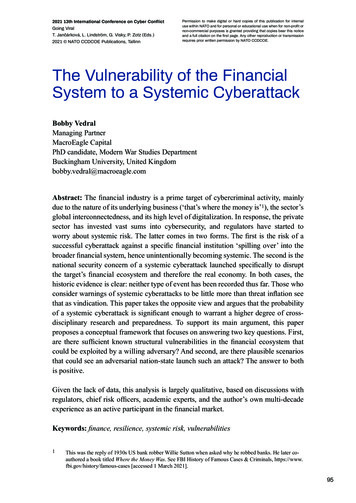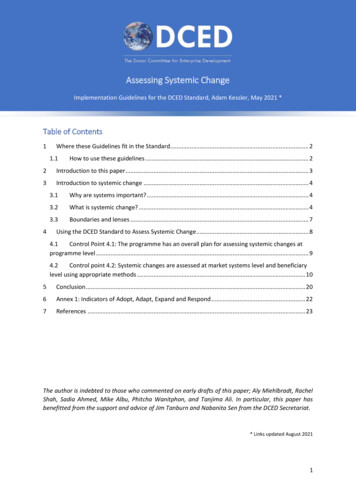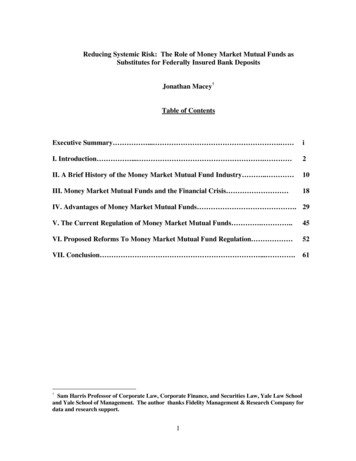
Transcription
Reducing Systemic Risk: The Role of Money Market Mutual Funds asSubstitutes for Federally Insured Bank DepositsJonathan Macey†Table of ContentsExecutive Summary . . iI. Introduction . . 2II. A Brief History of the Money Market Mutual Fund Industry . 10III. Money Market Mutual Funds and the Financial Crisis 18IV. Advantages of Money Market Mutual Funds . 29V. The Current Regulation of Money Market Mutual Funds . .45VI. Proposed Reforms To Money Market Mutual Fund Regulation 52VII. Conclusion . .61†Sam Harris Professor of Corporate Law, Corporate Finance, and Securities Law, Yale Law Schooland Yale School of Management. The author thanks Fidelity Management & Research Company fordata and research support.1
I.IntroductionIn the wake of the 2008-2009 financial crisis regulators and market participants havebeen focused on the perceived vulnerability of money market mutual funds (MMFs) tosystemic risk. The Securities and Exchange Commission has begun to reassess theriskiness of MMFs.2 More recently, the Treasury Department directed the President’sWorking Group (PWG) on Financial Markets to analyze how further to reduce thesystemic risk that MMFs may pose to the economy.3The point of this Article is to analyze MMFs and to show that, viewed properly, suchfunds significantly reduce systemic risk. Certain contemplated changes to the way thatMMFs are regulated would increase systemic risk by weakening the role of MMFs in themoney markets and increasing market participants’ reliance on commercial banks.In September 2008, there had been a “run” on certain MMFs when, after the collapseof Lehman Brothers, many investors rushed to redeem their shares. This influx of sellerscaused concern that some MMFs would drop below their target price of 1.00 per share –an extremely rare occurrence known as “breaking the buck” that is highly unsettling toinvestors. Though September 2008 marked only the second time in history that a MMF fellbelow 1.00 since the product’s creation in 1971,4 the occurrence provoked the SEC to2In response to the issues that affected money market mutual funds in late 2008 after Lehman Brothers’bankruptcy filing, the SEC made significant changes to the regulation of such funds. See Money MarketFund Reform, Inv. Co. Act Rel. No. 29,132 (Feb. 23, 2010), available . (accessed November 30, 2010); see also BenjaminHaskin, Margery Neale and Ryan Brizek, “SEC Adopts Money Market Fund Reforms,” The MetropolitanCorporate Counsel, April 5, 2010, available ype view&artMonth November&artYear 2010&EntryNo 10803, accessed November 30, 2010.3Report of the President’s Working Group on Financial Markets, “Money Market Fund Reform Options,”October, 2010.4The first occurrence was in 1994 when concerns over exposures to interest rate derivatives led investors towithdraw from a particular fund that had taken excessive risk.2
enhance its regulations of MMFs. Thus far, the SEC’s regulatory changes fall into threemain categories: 1) enhanced risk limitations, 2) special provisions for MMFs that breakthe buck, and 3) more stringent constraints on repurchase agreements.5 Additional changesare being considered.This paper considers the role of MMFs in our financial markets and calls intoquestion the assertion that these funds pose risks to the financial system. It proceeds first bydemonstrating the centrality of mutual funds to our financial system and specifically therole of MMFs. Subsequently, the paper explains the operation of these funds in layman’sterms and the convenience they present to investors. It then proceeds to consider the role ofthese funds in the 2008 financial crisis. Having argued that MMFs did not cause orexacerbate the crisis, the paper highlights the advantages that MMFs bring to investors.Finally, it examines the current regulation of MMFs and further proposed changes.Ultimately, the paper argues that over-regulation of MMFs threatens to destroy their valueand only to increase the systemic risks to society.An Introduction to Mutual Funds and Money Market Mutual FundsMutual funds are investment vehicles (organized normally as a corporation or abusiness trust) that use the capital raised from the sale of shares to investors to construct aportfolio of investments. The returns to investors in the mutual fund are a straightforwardfunction of the income and capital gains (or losses) of the mutual fund’s investmentportfolio. The job of the fund manager is to invest the money received from the sale ofthese mutual fund shares appropriately in light of the structure of the fund and theinvestment objectives of the people whose money is being invested. Mutual funds play a5As summarized by the PWG. Money Market Fund Reform Options, Report of thePresident’s Working Group on Financial Markets, Oct. 2010 [hereinafter PWG Report].3
critical role in our economy. At the end of 2008, the United States had over 16,000 mutualfunds with aggregate assets in excess of 9.6 trillion.6 For further perspective, mutual fundcompanies held 19% of the total financial assets of U.S. households, and invested on behalfof 45% of all U.S. households (92 million individuals, comprising 52.5 millionhouseholds).7 As of October 2010, money market mutual funds had nearly 3 trillion of thetotal amount under management.8 Mutual funds are particularly popular in the UnitedStates, where roughly one-half of the world’s mutual fund industry is located.9The value of a share in a mutual fund is called the “Net Asset Value” of the fund. TheNet Asset Value or “NAV” of a mutual fund is the net value of all of its assets(investments) divided by the number of shares outstanding. Thus, the NAV approximatesthe liquidation value of an investor’s shares in a fund. It is the price at which investors canbuy fund shares or sell them back to the fund. The fund manager calculates the NAV of thefund each day and, when an investor wants his money back, the fund buys (or “redeems”)the investor’s shares at the price per share.Money market mutual funds – the target of the new SEC regulations – are a genus of“open-end” mutual funds. In an open-end mutual fund, the investors who put their moneyin such funds gain access to their money by “redeeming” their shares. Redemption issimply a demand by an investor to receive the cash equivalent of the investor’s shares.Money market mutual funds are known as such because they invest in what areknown as “money market” instruments. These are securities with very short maturities thattend also to pose only negligible investment risk. MMFs invest in short-term (one day to6INV. CO. INST., 2009 INVESTMENT COMPANY FACTBOOK: A REVIEW OF TRENDS AND ACTIVITY INavailable at http://www.icifactbook.org/pdf/2009 factbook.pdf.7Id. at 8 & 72-73.8PWG Report, at 2.THE INVESTMENT COMPANY INDUSTRY 19,4
397 day) debt obligations, such as Treasury bills, federal agency notes, certificates ofdeposit, commercial paper, and repurchase (or “repo”) agreements. 10 (See Figure 1).Treasury bills are government promissory notes issued by the U.S. Treasury Departmentwith maturity dates of up to one year; federal agency notes are securities issued to fund theoperations of federal agencies, such as Fannie Mae or Freddie Mac (note that theseshort-term agency debentures are different from long-term agency mortgage-backedsecurities that consist of underlying residential mortgage loans); bank certificates ofdeposit (issued by both foreign and domestic banks) are bank-issued debt instruments thatpay interest; commercial paper involves short-term obligations issued by banks andcorporations; and repo agreements involve the buying of securities on a short-term basiscoupled with an obligation by the original seller to repurchase the securities from the buyerat a fixed price at a later date.9Id. at 20.Money market funds may only purchase U.S. dollar denominated assets.105
FIGURE 1Selected Money Market InstrumentsMarch 2010TotalMoney market fund holdingsBillions of dollarsTotal taxable instrumentsBillions of dollarsPercentage of total 11,370 2,361Agency securities1Commercial paper1,1671,0814754574142Treasury securities22,57838215Repurchase s of deposit5Eurodollar deposits421%1Debt issued by Fannie Mae, Freddie Mac, and the Federal Housing Finance Agency due to m ature by the end of March 2011; category exludesagency‐backed mortgage pools.2Marketable Treasury securities held by the public due to mature by the end of March 2011.3Repurchase agreements with primary dealers; category includes gross overnight, continuing, and term agreements on Treasury, agency, mortgage‐backed, and corporate securities.4Certficates of deposit are large of jumbo CDs, which are issued in amounts greater than 100 ,000.5Category includes claims on foreigners for negotiable CDs and non‐negotiable deposits payable in U.S. dollars, as reported by banks in the U.S. forthose banks or those banks' custom ers' accounts.Sources: Investment Com pany Institute, Federal Reserve Board, U.S. Treasury Departm ent, Fannie Mae, Freddie Mac, Federal Housing FinanceAgency, and Federal Reserve Bank of New YorkSource: Investment Company InstituteMMFs are designed to serve the needs of investors whose primary goal is thepreservation of principal, and who are willing to accept a modest return on their investmentportfolio in return for more safety and liquidity. From an economic perspective, MMFs area substitute for the checking accounts offered by banks and provide consumers a viablealternative to banks.11 People who keep their money in MMFs, like those who keep theirmoney in federally insured depository institutions such as commercial banks and creditunions, expect to be able to obtain cash from their funds virtually on demand, and theyexpect that the value of their investments will not decline in nominal terms.11RICHARD CARNELL, JONATHAN MACEY & GEOFFREY MILLER, THE LAW OF BANKING AND FINANCIALINSTITUTIONS 604 (4th ed. 2009).6
The moniker “money market” mutual fund distinguishes MMFs from the other sortsof mutual funds, which are designed more for long-term investors rather than for theshort-term savers who typically patronize MMFs. The defining feature of a MMF and thecharacteristic that distinguishes MMFs from other mutual funds is that MMFs generallyare able to maintain a stable NAV of 1.00 per share by keeping their risk exposures lowand by buying short-term debt securities from issuers whose financial strength makes themhighly unlikely to default prior to the date on which the securities mature.For all sorts of mutual funds, including MMFs, the Investment Company Act of194012 nominally requires that each fund calculate its NAV each day on the basis of thecurrent market value of the securities held by the fund. In the case of MMFs, however, theSEC has exercised its authority to carve out exemptions from this general rule. Under thisexemptive authority, the SEC has ruled that under certain conditions, MMFs can employaccounting procedures to calculate the value of the securities they own which permit themto offer a stable share value of 1.00.In order to maintain a constant share value, most MMFs use the "amortized cost"method of valuation. Under this method securities are valued at acquisition cost rather thanmarket value, and interest earned on each security (plus any discount received or less anypremium paid upon purchase) is accrued uniformly over the remaining maturity of thepurchase. By declaring these accruals as a daily dividend to its shareholders, the fund isable to maintain a stable price of 1 per share.13Money funds may also use a second procedure called "penny rounding" to maintain astable share value, although I am not aware of any money funds currently relying on this1213Pub. L. No. 76-768 (August 22, 1940), codified at 15 U.S.C. § 80a-1-64.Id.7
approach. Under this procedure the share value is calculated by rounding the per sharemarket value of the fund to the nearest cent on a share value of a dollar. If the market valueof a share is kept within one-half cent of a dollar, this accounting procedure allows thefunds to offer a stable 1 share value. Thus, if a MMF has a net asset value of 0.995, thefund could quote a price of 1.00 because the SEC allows the 0.995 NAV (which is withinone-half cent of a dollar) to be rounded up to 1.00.A large number of factors can cause the NAV of well-managed MMFs to fall belowor rise above 1.00. For example, a swift upward adjustment in interest rates could reducethe value of portfolio securities below the 1.00 NAV level. Some classes of assets held bythe fund could decline in value. As the average maturity of the securities in a MMF’sportfolio increases, so too does the possibility that the NAV will vary somewhat from 1.00.14 Although most attention is paid to NAVs potentially falling below 1.00, a fund’sNAV could also exceed 1.00.Over time, two major customer constituencies for MMFs have emerged. One groupof investors is individual (or “retail”) investors who use MMFs instead of, or as asupplement to, their demand deposit accounts and savings accounts. Retail investors alsouse MMFs to hold cash temporarily or to take a temporary defensive position inanticipation of declining equity markets. As of December 2009, about one fifth of U.S.households’ cash balances were held in MMFs.15The second core clientele of MMFs is large institutions, such as bank trustdepartments, corporations, brokerage accounts, state and local governments, hedge funds,14Id.See INV. CO. INST., 2010 INVESTMENT COMPANY FACTBOOK: A REVIEW OF TRENDS ANDACTIVITY IN THE INVESTMENT COMPANY INDUSTRY 8, available athttp://www.ici.org/pdf/2010 factbook.pdf.158
and retirement plans. The largest institutional investors in MMFs are corporations16 thatpurchase MMFs directly or indirectly through an intermediary and who use the funds forcash management purposes. A special category of MMFs, generally labeled"institutional-only," has evolved to deal with institutional investors. These funds offer anarray of services specially designed to meet the needs of institutions, such as electronichookups between the institutions and the fund and sub-accounting services to facilitaterecordkeeping of banks’ trust accounts.17 Many corporate treasurers of large businesseshave essentially “outsourced” cash management operations to money market mutual funds.As of January 2008, approximately 80 percent of U.S. companies used moneymarket funds to manage at least a portion of their cash balances.18 U.S. non-financialbusinesses held approximately 32 percent of their cash balances in money market mutualfunds. The prominence of institutional investors in MMFs is a relatively recentphenomenon. From 1998 to 2008, institutional money fund assets grew by 380 percentcompared to 63 percent for non-institutional money fund assets. 19 According to theInvestment Company Institute (“ICI”), the national association of U.S. investmentcompanies (including money market mutual funds), about 66 percent of money marketfund assets are now held in money market funds or share classes intended to be sold toinstitutional investors.20MMFs typically require a minimum initial investment from clients in the range of 500 to 5,000 for retail investors. MMFs geared towards institutions often have much16Id. at 181, tbl. 59.Cook and Duffield, supra note 12, at 159.18See Inv. Co. Inst., Report of the Money Market Working Group, at 21 (Mar. 21, 2009), available athttp://www.ici.org/pdf/ppr 09 mmwg.pdf (hereinafter “ICI Report”).supra note 7, at 28-29, Figure 3.7.19See Inv. Co. Inst., Money Market Mutual Fund Assets, June 11, 2009http://www.ici.org/highlights/mm 06 11 09 (last visited April 24, 2010).179
higher minimum initial investment requirements. MMFs historically required customersto maintain fairly large balances, but that requirement has been relaxed over the pasttwenty years. Retail MMFs typically permit their investors to write checks against theiraccounts, or to transfer funds electronically, though there may be restrictions on how manytimes per month such withdrawals can be made.While MMFs are the safest category of mutual funds, they historically have not beeninsured by the federal government. Because of the low risk associated with money marketassets, such insurance never has been considered necessary. Moreover, because MMFinvestors, like other mutual fund investors, are equity claimants and are entitled only to theNAV or their pro rata share of the value of the MMF’s assets, it is not possible for a mutualfund to fail in the way that a bank, whose depositors own fixed contractual claims forspecific nominal sums, can fail. If a mutual fund’s assets decline in value, its investors facea similar decline in the value of their investments. A bank depositor, however, is entitled tothe same amount of money from the bank irrespective of any fluctuations in the value ofthe bank’s investments.It is possible, of course, for money market funds to suffer a decline in the NAV of thefund’s shares, which means that the NAV can fall to a price below 1.00 per share. But,because of the effective regulations governing MMFs, this risk has been, and remains,minimal. Historically, even including consideration of the recent crisis, MMFs have beenextremely safe.II. A Brief History of the Money Market Mutual Fund Industry20Id.10
MMFs date back to 1971 when the Reserve Primary Fund was launched. MMFsexperienced their initial period of rapid growth in 1974 and early 1975, as a result ofRegulation Q’s strict ceiling on the interest rates that insured depository institutions werepermitted to pay to depositors.21 In the high interest rate environment that existed duringthis period, money market rates of return rose well above the ceiling on interest that couldbe paid on deposits accounts. In order to outpace interest and achieve returns higher thanthose fixed by Regulation Q, many customers withdrew their assets from deposit accountsand placed their funds into money market mutual funds.22The level of MMF assets rose to almost 4 billion by mid-1975 and remained in therange of 3 billion to 4 billion until the end of 1977.23 Explosive growth in MMFsoccurred again in the late 1970s and early 1980s, when very high money market ratesproduced large differences in the rates of return being paid by MMFs and depositoryinstitutions. Also beginning in the late 1970s, a few of the largest firms introduced the“cash management account” (CMA), a type of MMF that includes check-writing features.CMA accounts provided customers with both market-sensitive yields and the transactional21The Banking Act of 1933, Ch. 89, 48 STAT. 162, commonly known as the Glass-Steagall Act, enacted threemajor reforms that defined banking regulation for the next several decades: (1) the separation of bankingfrom the securities industry; (2) the establishment of federal deposit insurance; and (3) federal controls overdeposit insurance, including the prohibition of interest-bearing demand deposits. The third reform, proposedas the Glass provision and enacted as Regulation Q, set limits on the interest rates that banks could pay theirdepositors. For a treatment of the legislative history of Regulation Q, see R. Alton Gilbert, Requiem forRegulation Q: What It Did and Why It Passed Away, Feb. 1986 FED. RES. BANK OF ST. LOUIS REV. 22 (1986),available at: Requiem Feb1986.pdf; Michael D. Schley,Interest on Demand Deposits: The Erosion of Regulation Q’s Last Stronghold, 4 ANN. REV. BANKING L. 23,29 (1985).22See, e.g., Arthur E. Wilmarth, Jr., The Expansion of State Bank Powers, The Federal Response, and TheCase For Preserving the Dual Banking System, 58 FORDHAM L. REV. 1133, 1143-44 (1990) (describing theimpact of the Fed’s monetary policy on disintermediation); Laurie S. Goodman and Sherrill Shaffer, TheEconomics of Deposit Insurance: A Critical Evaluation of Proposed Reforms, 2 YALE J. ON REG. 145, 152(1984) (arguing that “whenever market interest rates rise about Regulation Q ceilings, bank deposits fallsharply.”).23Cook and Duffield, supra note 12, at 157. See also Brian Reid, Inv. Co. Inst., Perspective: Growth andDevelopment of Mutual Funds 3, available at http://www.ici.org/pdf/per03-02.pdf (analyzing the growth ofmoney market mutual funds from 1970 to 2000).11
advantages of a checking account, and as a result MMF assets rose rapidly from 4 billionin 1977 to 235 billion in 1982.24In order to help banks compete with MMFs, in 1980 Congress passed the DepositoryInstitutions Deregulation and Monetary Control Act (the “DIDMCA”), which created acommittee charged with phasing out Regulation Q’s limitations on interest and dividendspaid to depositors by 1986. Two years later, Congress passed the Garn-St. GermainDepository Institutions Act, which directed this committee to provide depositoryinstitutions with an account that would be “directly equivalent to and competitive withmoney market mutual funds.”25 These accounts, known as money market deposit accounts(MMDAs), had no limits on the interest depositors could earn. Both the instructions of theDIDMCA and the moniker chosen for these accounts indicate that they were designed inorder to allow depository institutions to better compete with MMFs.26MMDAs were extremely successful at first, drawing 298 million within the firstfour months of their existence.27 The introduction of these accounts caused a predictablysharp drop in MMF balances; from November 1982 to the end of 1983, MMF assets fell by 67 billion.28 But over time the interest paid on MMDA accounts declined, and by 198624Arthur E. Wilmarth, Jr., The Transformation of the U.S. Financial Services Industry, 1975-2000:Competition, Consolidation, and Increased Risks, 2002 U. Ill. L. Rev. 215, n. 95 (2002); Cook and Duffield,supra note 12 at 157; Franklin R. Edwards & Frederic S. Mishkin, The Decline of Traditional Banking:Implications for Financial Stability and Regulatory Policy, FED. RES. BANK OF N.Y., ECON POL’Y REV. (July1995), at 31.2512 U.S.C. § 3503(c)(1)(1982).26See Timothy A. Canova, The Transformation of U.S. Banking and Finance: From Regulated CompetitionTo Free-Market Receivership, 60 BROOK. L. REV. 1295, 1319-20 (1995) (discussing MMDAs in the broadercontext of the abolishment of virtually all restrictions on the price of credit during the Reaganadministration).27See Hans H. Angermueller, Vice Chairman, Citicorp-Citibank, Speech at The Thrift Industry at theCrossroads Conference: The Third Industry: A Breath of Fresh Air (Mar. 25, 1983), in 3 ANN. REV. BANKINGL. 155, 160 (1984).28Cook and Duffield, supra note 12.12
MMF assets had returned to their 1982 levels. 29 Since that time, MMF assets havecontinued to grow, not only as a result of their competitive rates of return, but also becauseinvesting in the stock market in general and the mutual fund industry in particularexperienced significant growth. This has led to rapid growth because[I]nvestors often use MMFs as a parking place for cashreserves awaiting investment in longer-term financial assetssuch as stocks and bonds. They also frequently exchangeMMF shares for the shares of other funds in their mutualfunds group. Further, MMFs are generally the core vehiclein the popular cash management accounts offered by largebrokerage firms.30Another important historical feature of MMFs has been the support that such fundshave received from their mutual fund sponsors. Where there has been a risk of decline inthe value of a particular class of mutual fund assets, some MMF’s advisors have avertedthe specter of breaking the buck by purchasing securities from the MMFs in an effort tobring the funds’ NAVs back to 1.00. This has been a considerable source of strength forMMFs and a significant source of comfort to MMF investors, despite the fact that advisorsstrive to make clear that there are no guarantees to support their funds.For example, in 1989, when a major commercial paper issuer defaulted on 213million of outstanding paper, two MMFs held enough of the issuer’s paper to jeopardizetheir ability to maintain a 1.00 NAV. The funds' advisors averted the possibility of adecline in the 1.00 share value by purchasing the commercial paper from the funds. Ayear later, two additional issuers defaulted on their commercial paper, and in this case aswell, the advisors of MMFs holding these funds came to the rescue by purchasing the2930Id.Id. at 159.13
troubled commercial paper from the funds at a price sufficient to maintain the fund’sNAV.31 Despite the lack of any losses to investors, as a result of these problems in thecommercial paper market, the SEC strengthened even further the restrictions on MMFs.In 1991, the SEC amended Rule 2a-7 of the Investment Company Act of 1940 torequire MMFs that wanted to continue to use the amortized cost or penny-roundingaccounting methods to comply with new maturity, credit quality and diversification rules.Specifically, the SEC ruled that the MMF had to invest 95 percent of its assets in"First Tier" securities, which generally speaking wasdefined to include Treasury securities or privately issuedsecurities rated A1-P1, and had to invest the remainder in"Second Tier" securities, which are those rated A2-P2. TheSEC also required that a fund invest no more than 1 percentof its assets in any particular Second Tier company or 5percent of its assets in any First Tier company. Finally, theSEC lowered the average maturity requirement from 120 to90 days.32At this time, the SEC promulgated its rule making it illegal for a registered mutualfund to describe itself as a “money market” fund unless it met the stringent requirements ofRule 2a-7. This provision effectively defined a money market fund as a mutual fund thatfollows the risk-limiting provisions of Rule 2a-7. And, significantly, since 1991 the SEChas required that a money market fund prospectus prominently disclose that the MMF'sshares are neither insured nor guaranteed by the U.S. government and that there is noassurance that the funds will be able to maintain a stable value of 1 per share. The express31Id.Id.; see also, Leland Crabbe and Mitchell Post, The Effect of SEC Amendments to Rule 2a-7 on theCommercial Paper Market, Finance and Economics Discussion Series # 199, Washington: Board ofGovernors of the Federal Reserve System (May 1992) (demonstrating the reduction in MMFs' holdings ofA2-rated paper following the imposition of this regulation and conclude that the regulation raised the interestrate on A2 paper relative to the rate on A1 paper).3214
purpose of this rule is to increase investor awareness that investing in a money market fundis not without risk.The new regulation did not deter securities firms from establishing money marketmutual funds. In 1992, MMFs represented 544 billion in deposits, while other mutualfunds such as bond and equity funds managed over 1 trillion in investor funds.33In 1994, many money market funds experienced portfolio losses, but their investorswere again shielded from any loss when managers made up for these losses themselves.34In one case, however, fund managers found themselves unable to redeem investor shares.Community Bankers Mutual Fund, Inc., a small MMF catering to small community bankshad made ill-timed investments in adjustable rate securities, which lost value as interestrates climbed in 1993-94. The Fund had 35.5 million of its 82.2 million in assets inderivatives when it was forced to liquidate its assets to redeem shares.35 This was the firsttime in the 23-year history of MMFs that a fund broke the buck, and no further failureswould occur until 14 years later, at the height of the financial crisis in 2008.Arthur Levitt, Jr., then Chairman of the SEC, warned investors that there is noguarantee that MMFs will maintain a stable 1.00 NAV. “The moral is that any fund canlose money,” said Levitt. “This serves as a warning of the steps the S.E.C. needs to take toprotect investors who are not aware of the risk they are undertaking.”3633David G. Oedel, Puzzling Banking Law: Its Effects and Purposes, 67 U. COLO. L. REV. 477, 498 (1996).In 1994, BankAmerica and 13 other banks or brokers paid 60 million to cover derivative losses in twomoney market funds. The Paine Webber Group put up 268 million to cover customer losses, and PiperJaffray Companies put up 25 million in a fund that lost 700 million from derivatives. See Leslie Wayne,Investors Lose Money in “Safe” Fund, N.Y. TIMES, Sept. 28, 1994, at D1; Chart, “Pumping Money IntoTheir Funds,” id. at D6 (listing fifteen MMFs whose advisors covered for shortfalls in 1994 or 1994, bailingout their funds to avoid “breaking the buck.”).35Id.36Id.3415
In the last decade or so, the biggest change in money market mutual funds has beenthe dramatic increase in the number of institutional investors in money market funds. Fromthe end of 1998 to the end of 2008, retail money market mutual funds grew fromapproximately 835 billion to 1.36 trillion, or 63 percent, while institutional moneymarket fund assets grew from approximately 516 billion to 2.48 trillion, a staggering 380percent. (See infra Figure 2; Figure 3).16
FIGURE 2Figure 3.2: Assets of Money Market Funds in Retail andInstitutional Share Classes34%March 2010Retailshare classes( 1.0 trillion)66%Institutionalshare classes( 2.0 trillion)Source: Investment Company InstituteFIGURE 3Figure 3.3: Selected Characteristics of Retail and Institutional Money Market Fund Share ClassesMarch 2010RetailInstitutionalMedian minimum initial investment 1,000 1 millionMedian average account balance* 56,318 4.4 millionPercentage of funds offering check writing62%12%Total number of shareholder
Money market mutual funds are known as such because they invest in what are known as "money market" instruments. These are s ecurities with very short maturities that tend also to pose only negligible investment risk. MMFs invest in short-term (one day to . 6 INV. CO. INST., 2009 INVESTMENT COMPANY FACTBOOK: A REVIEW OF TRENDS AND ACTIVITY IN


